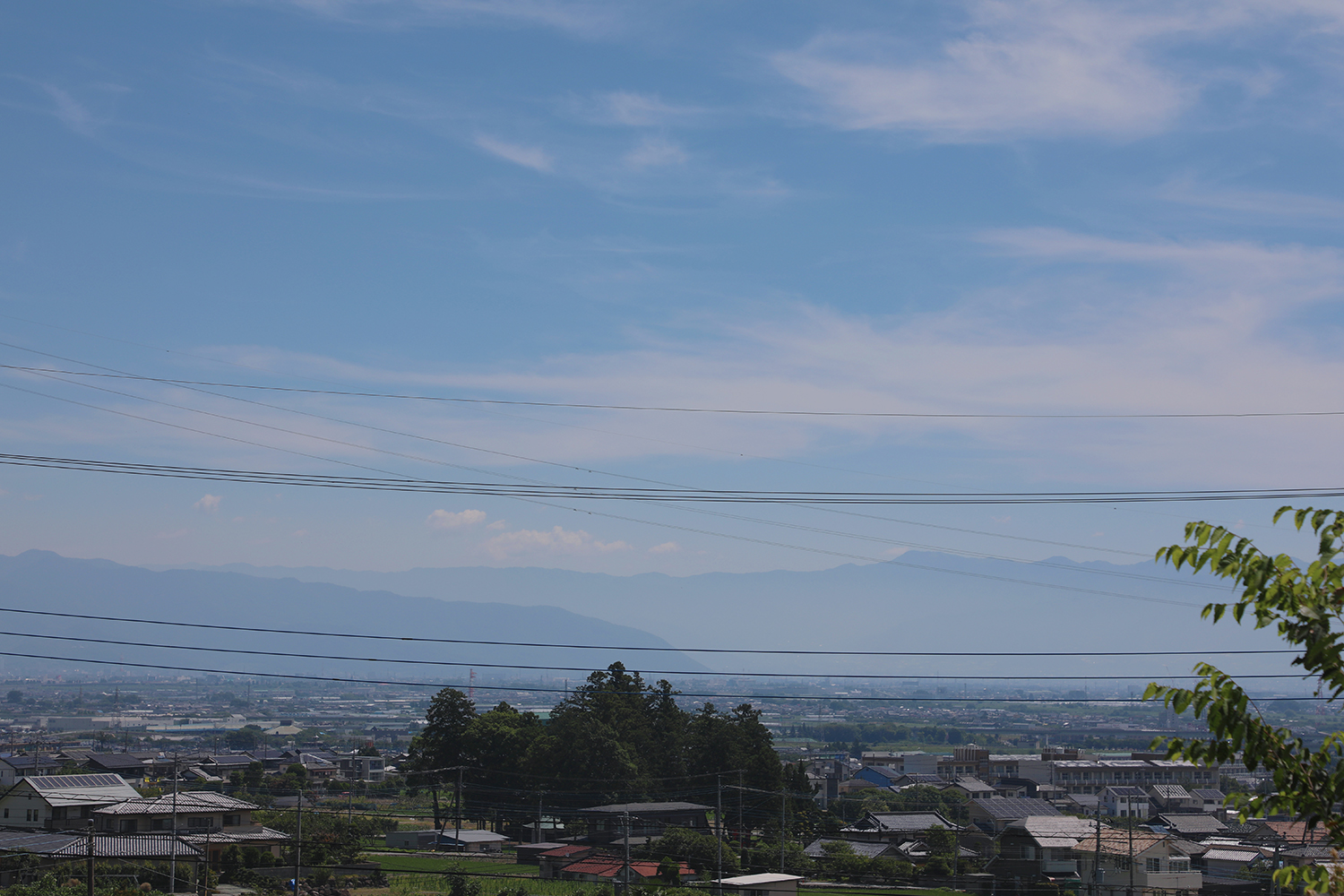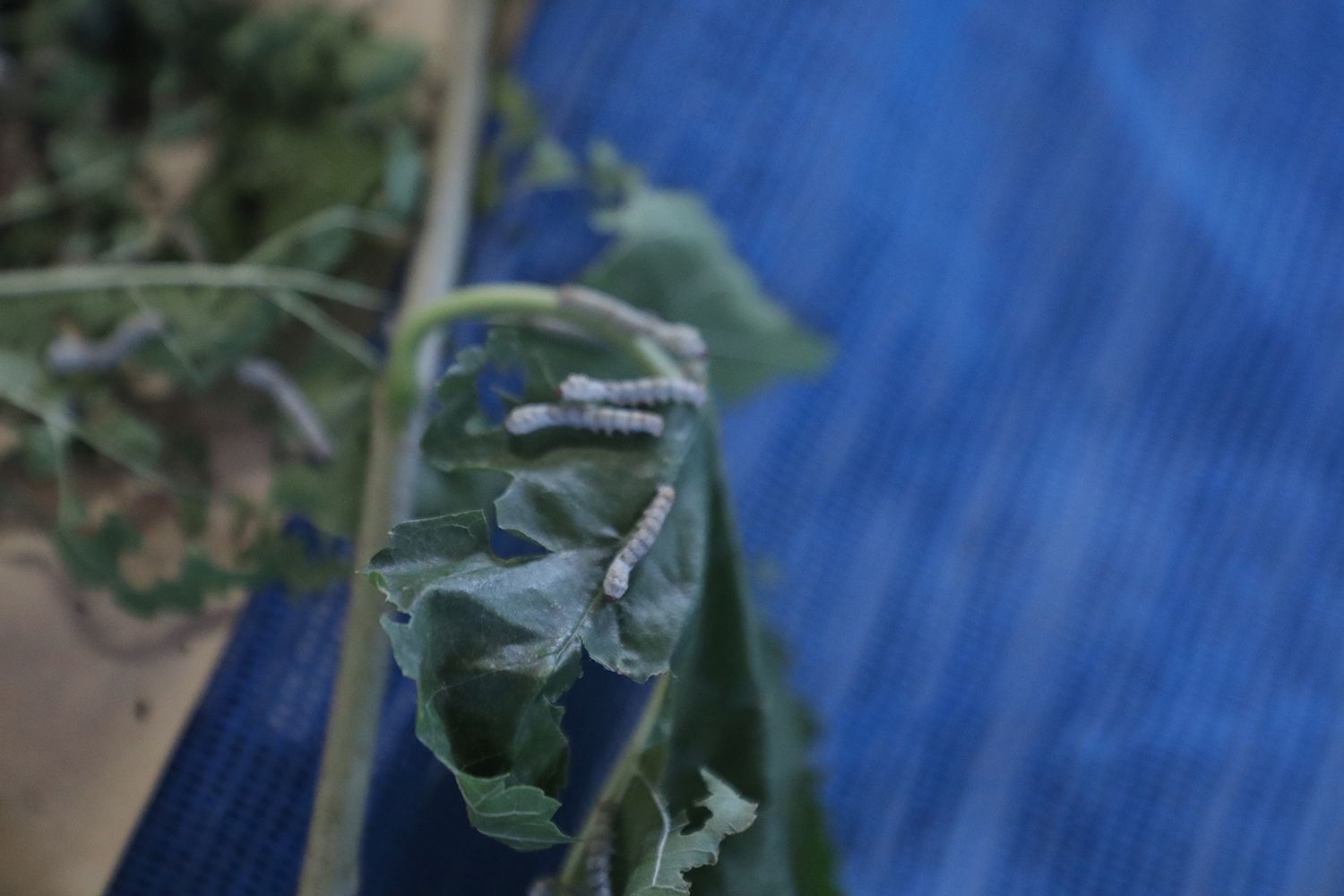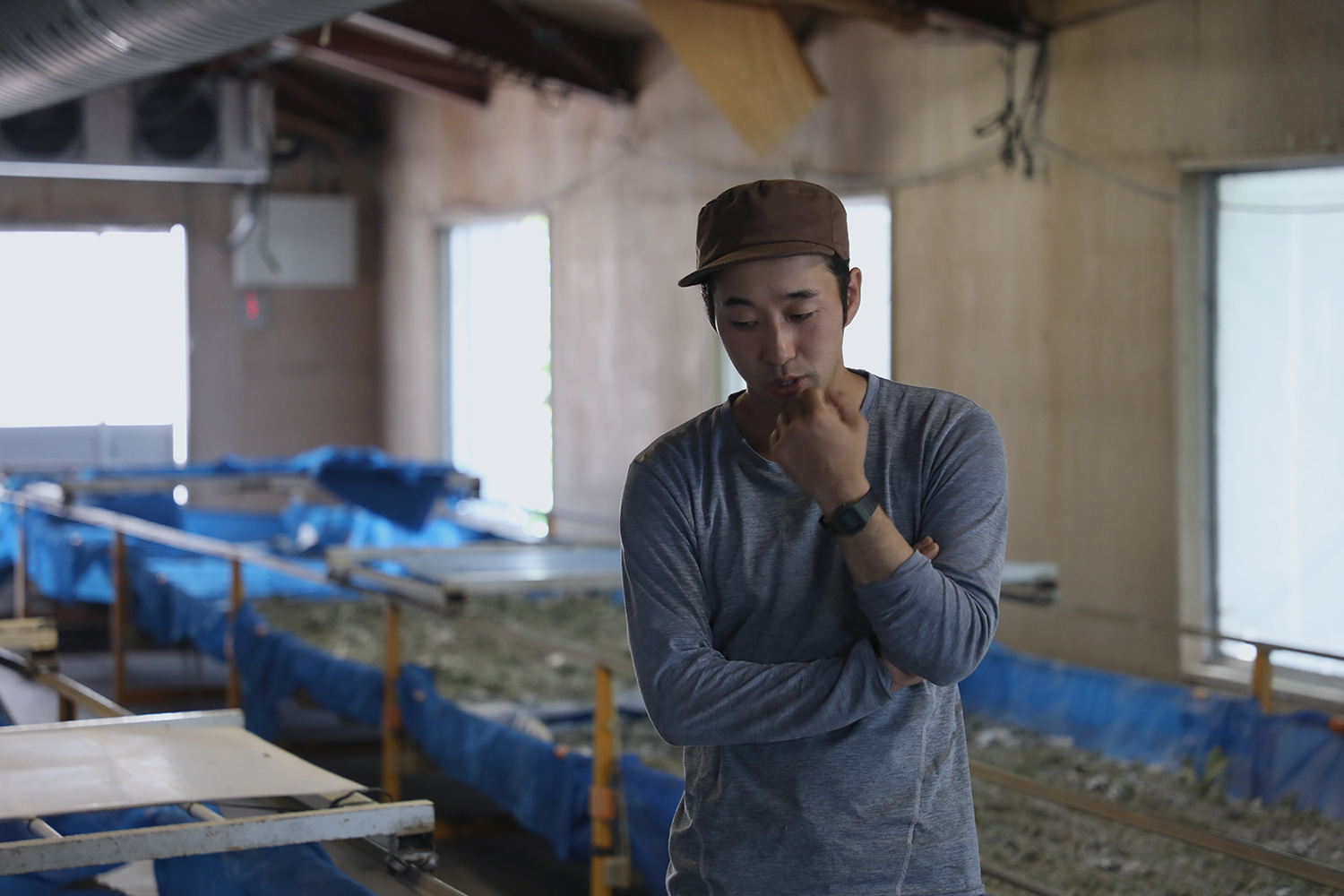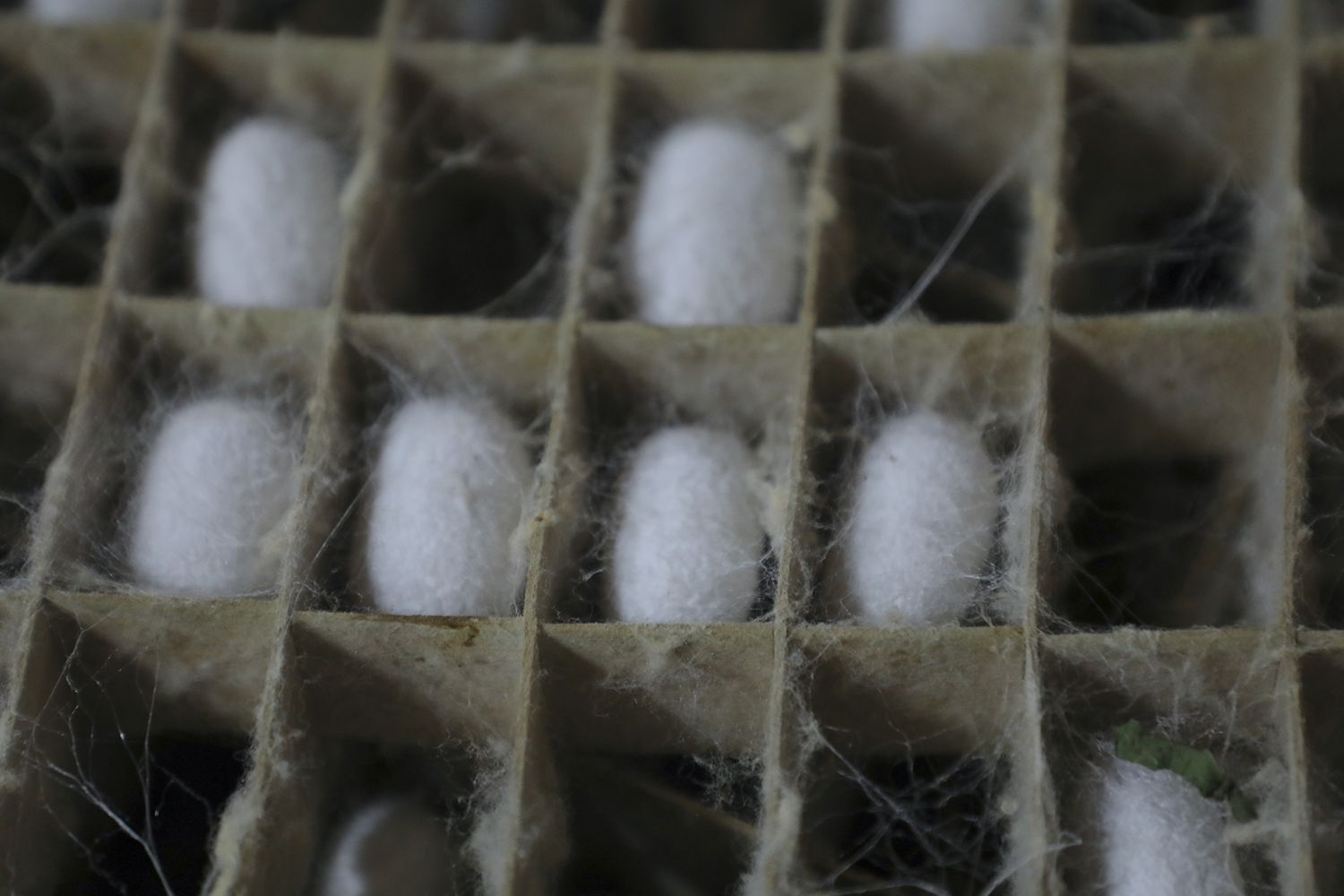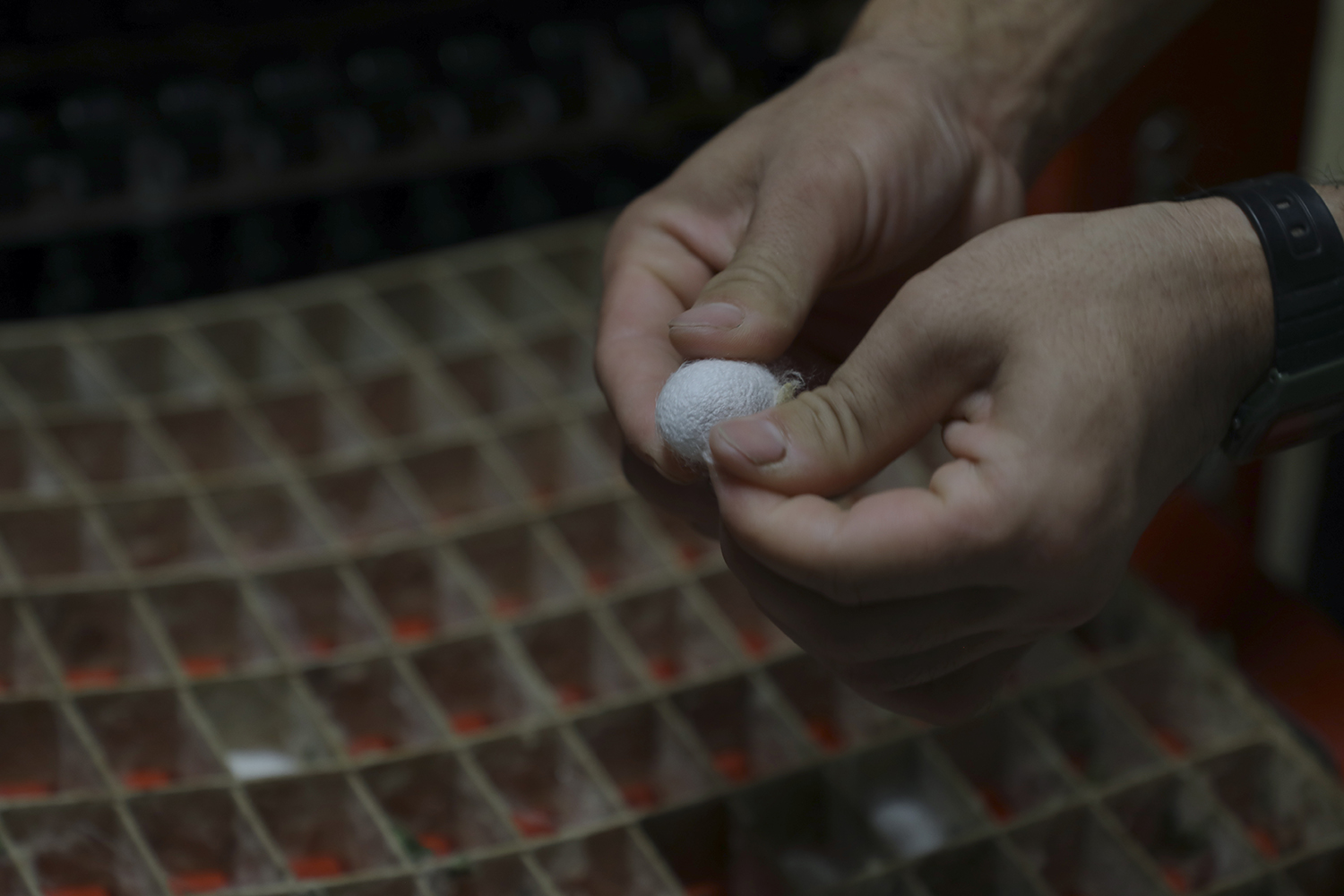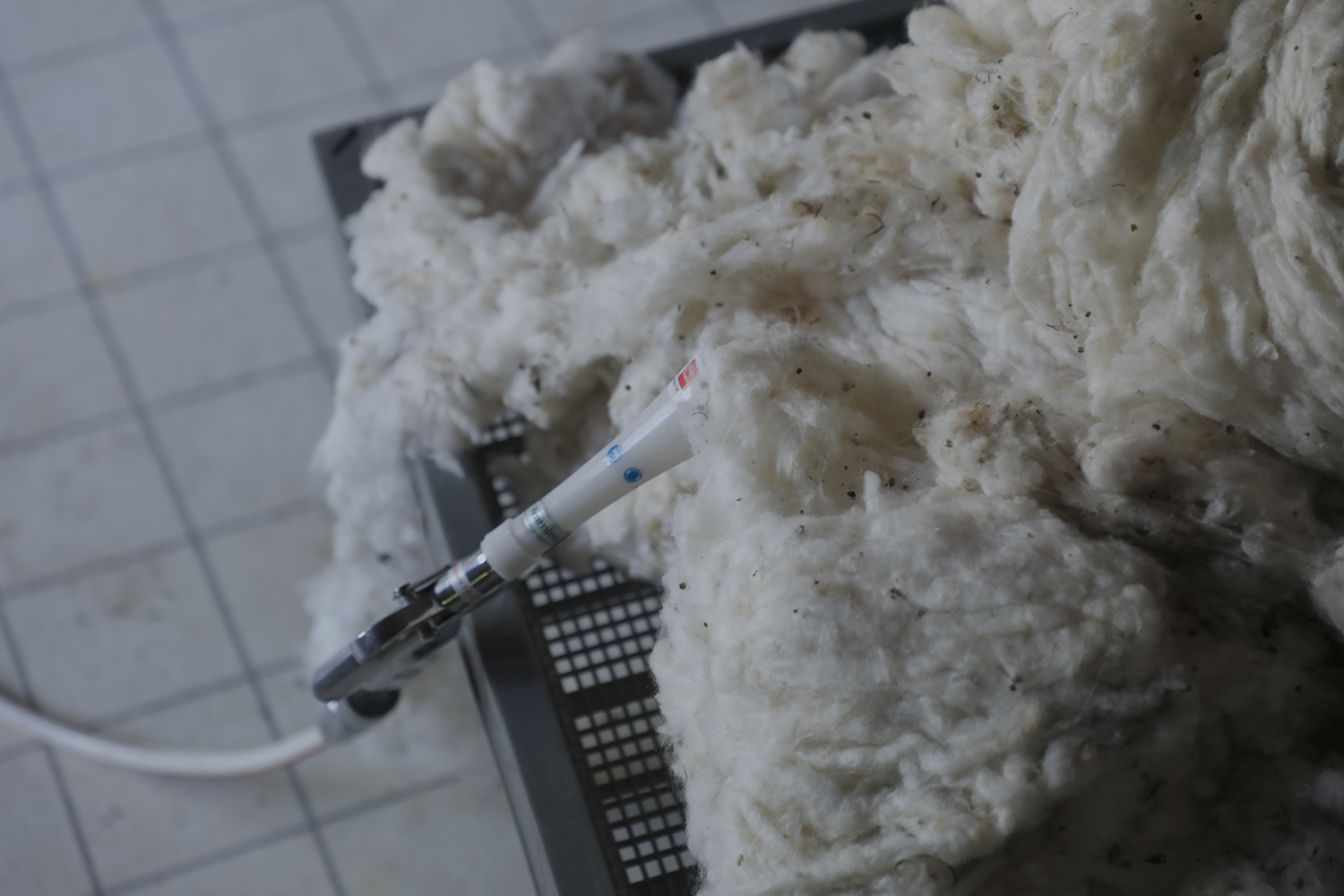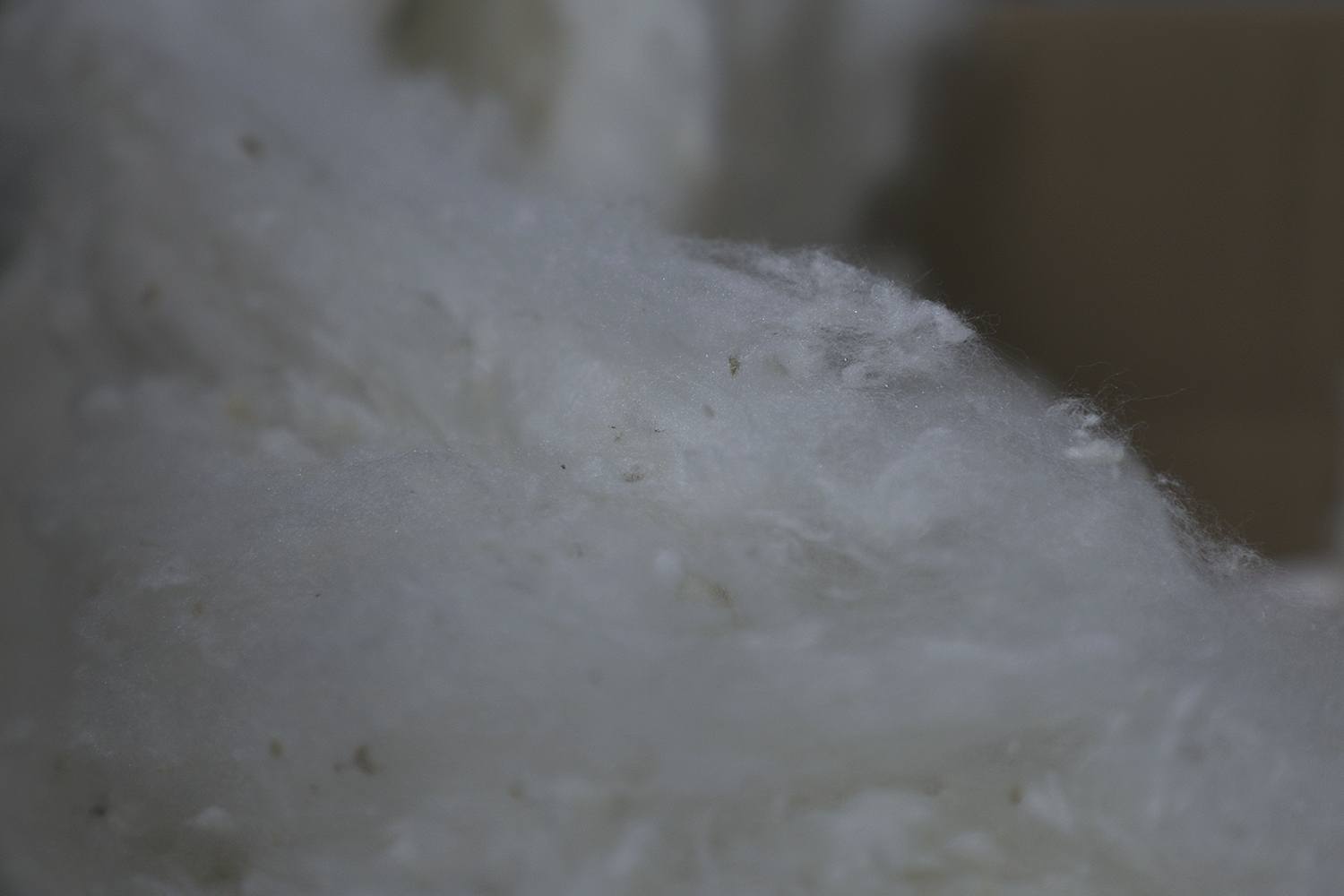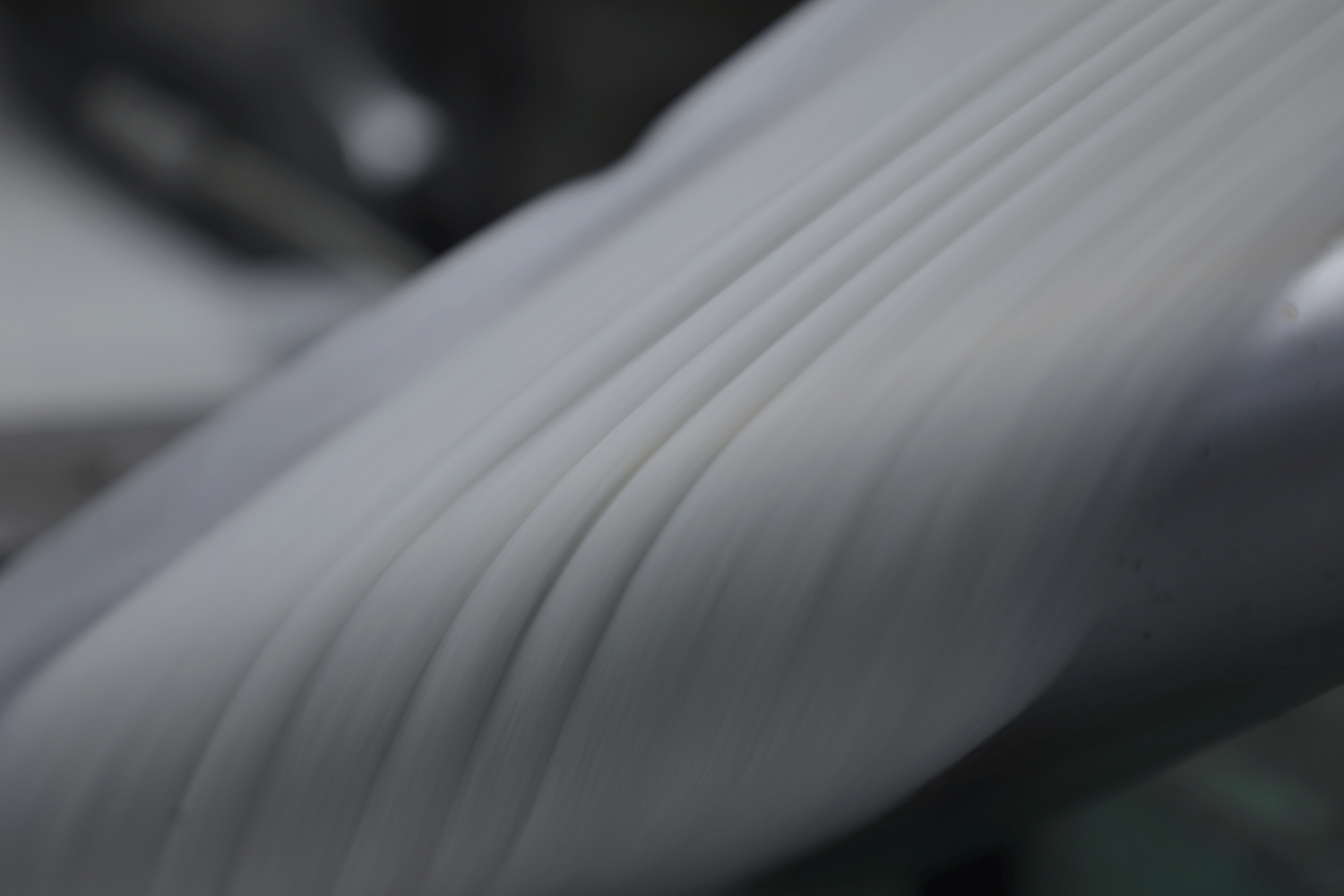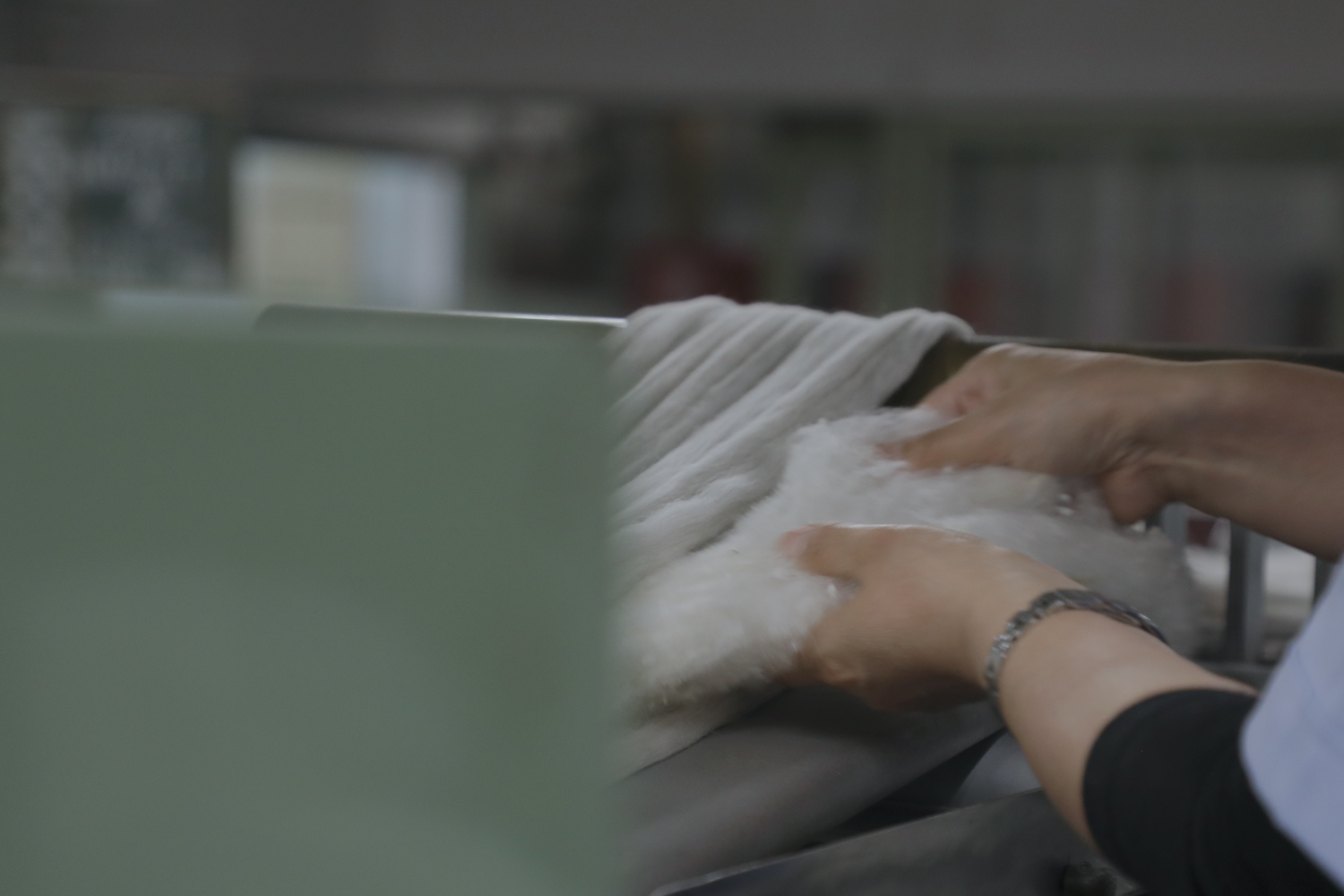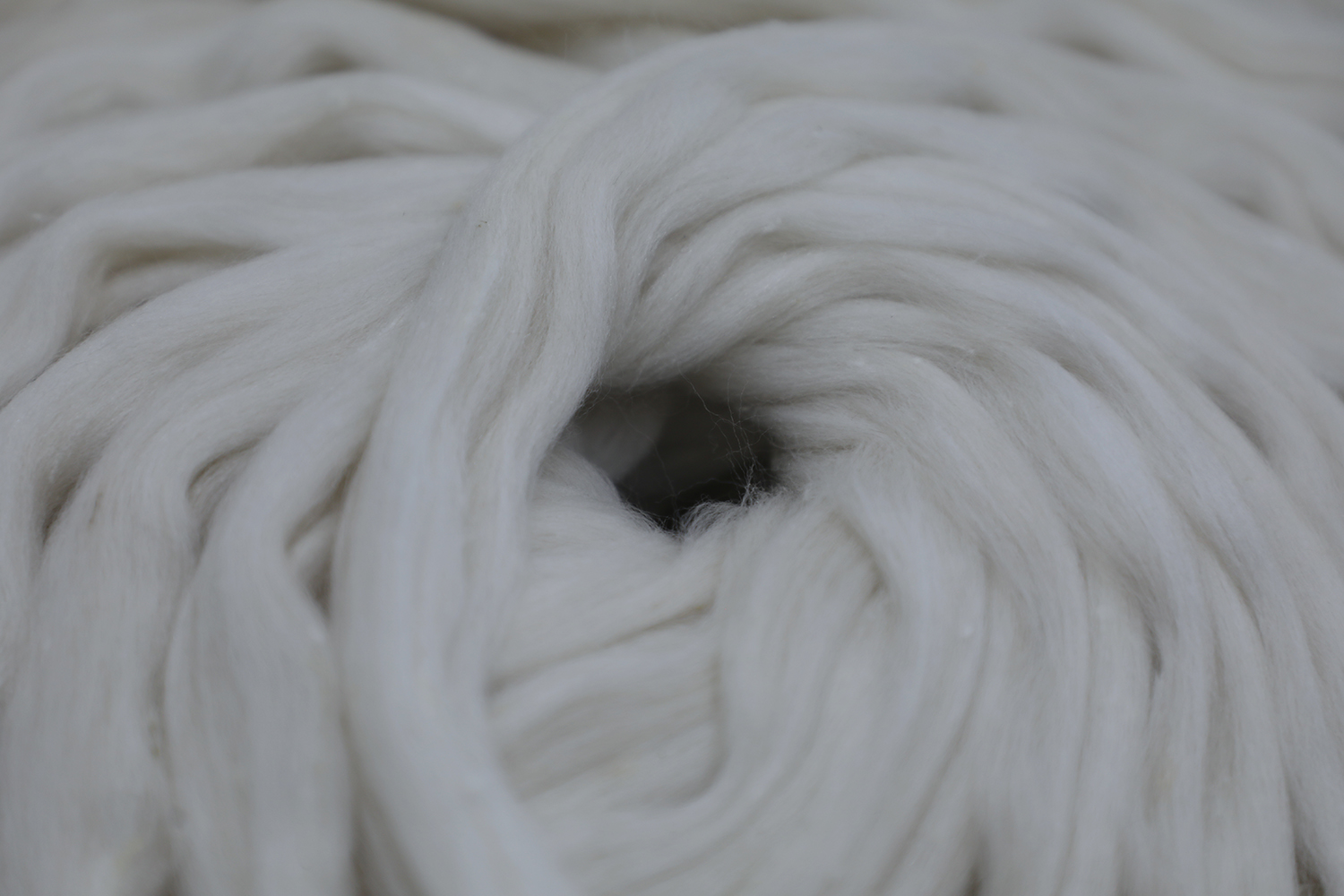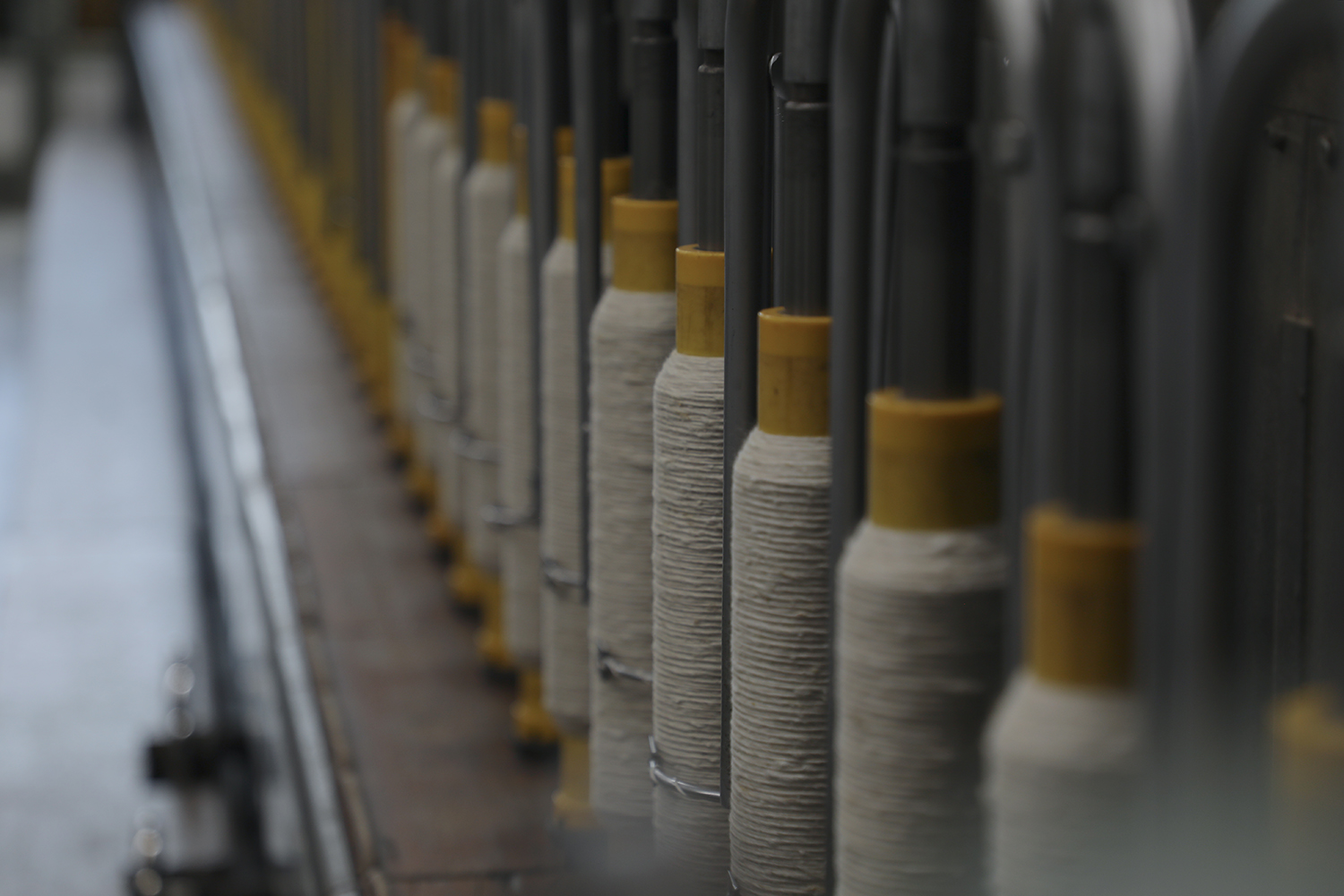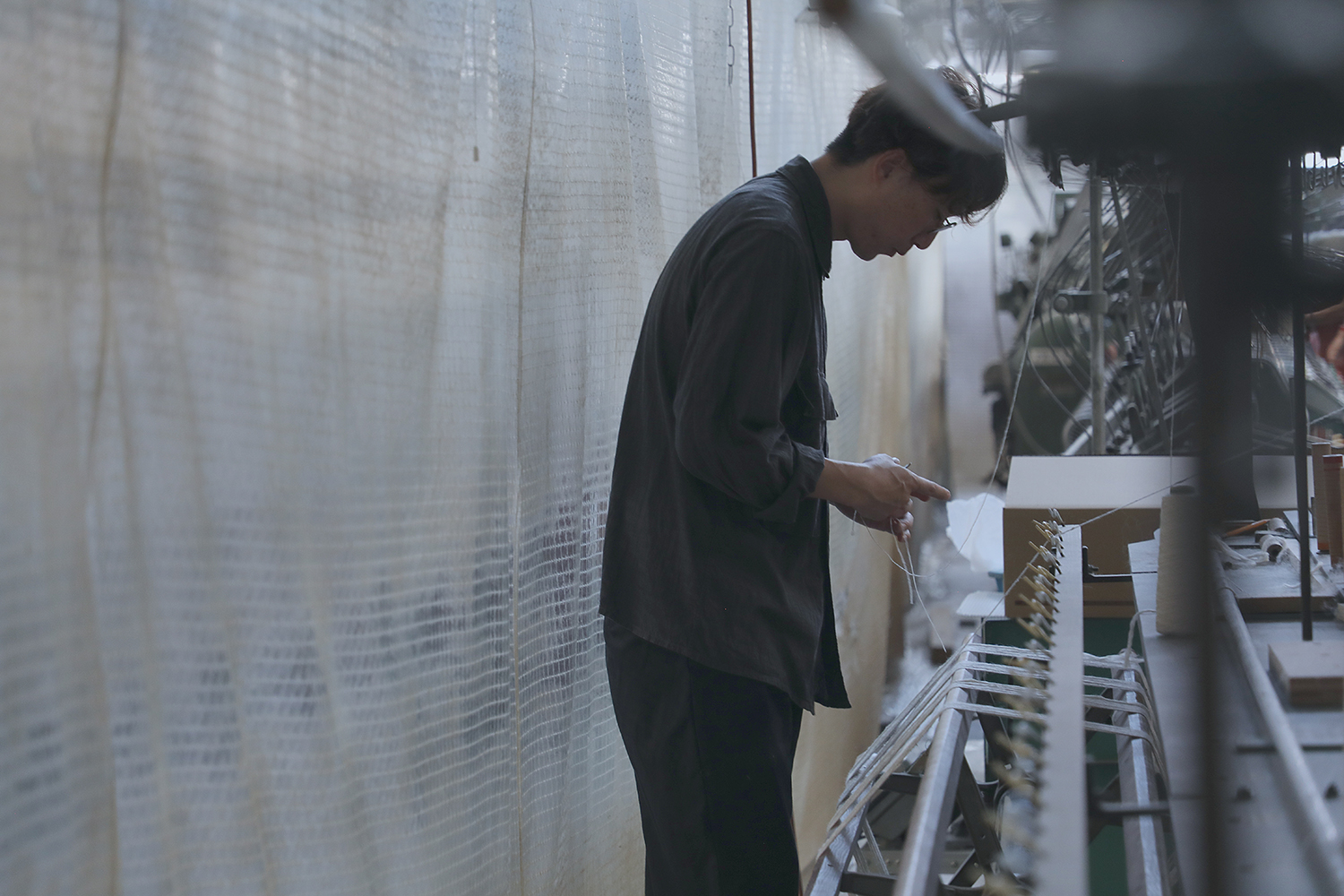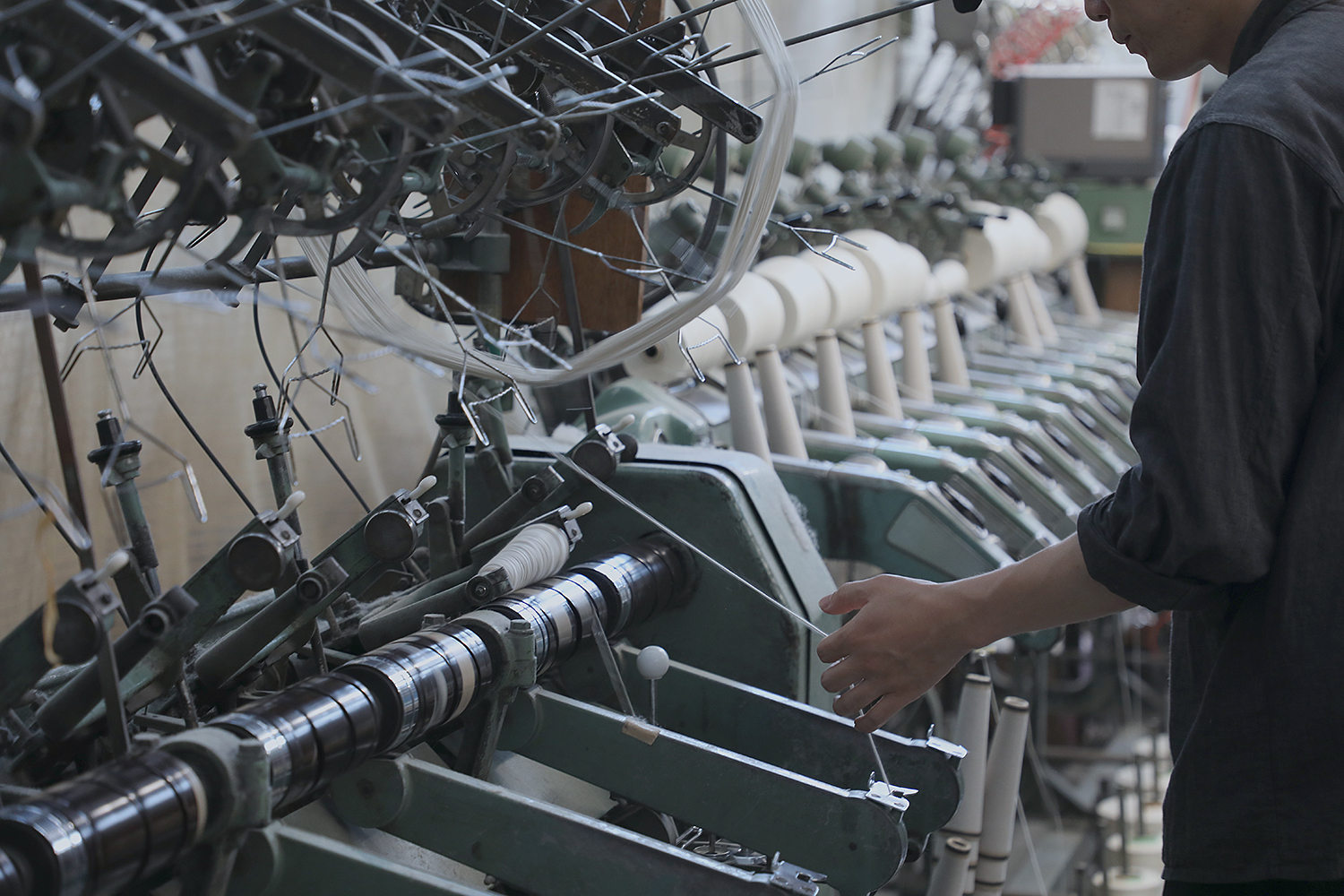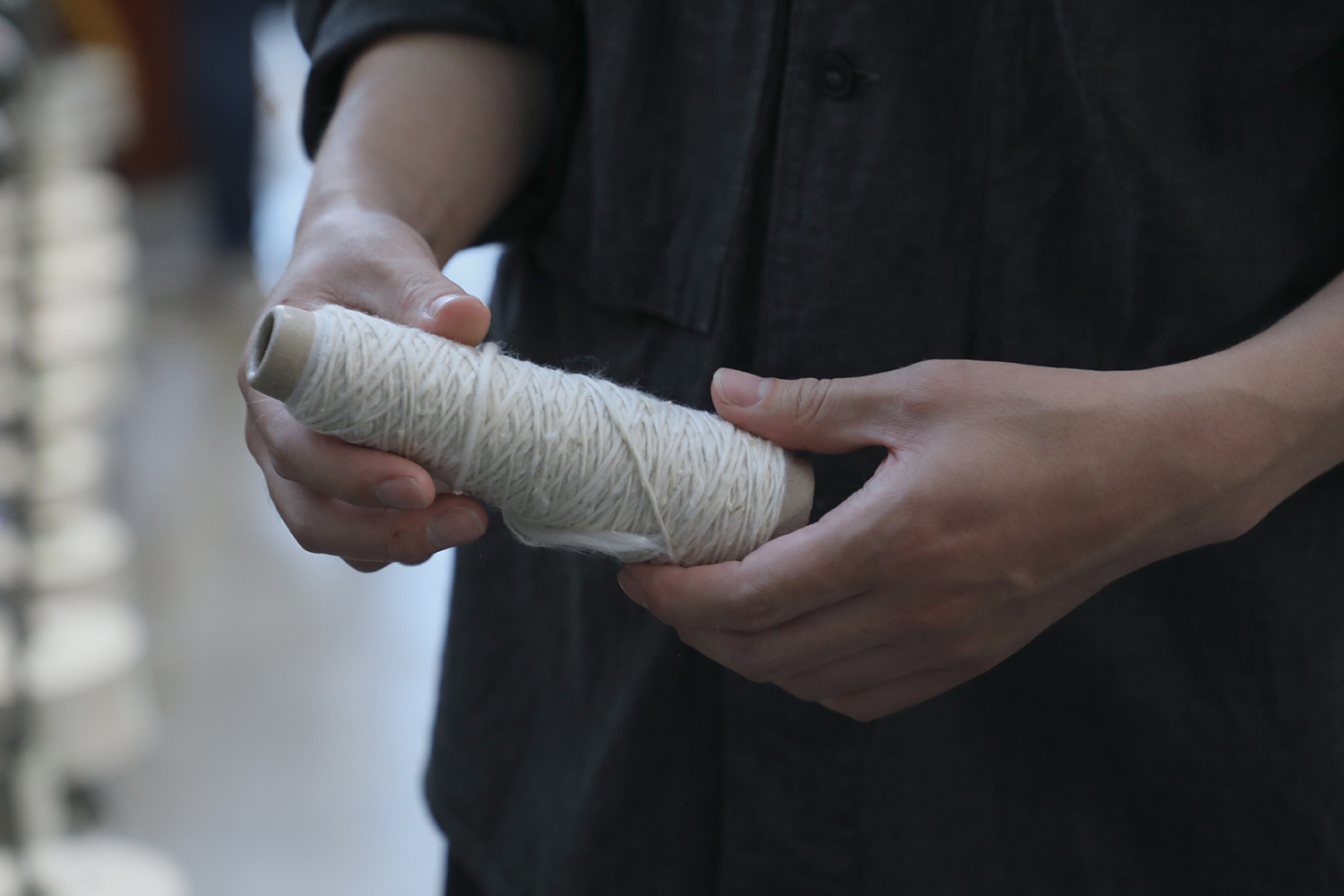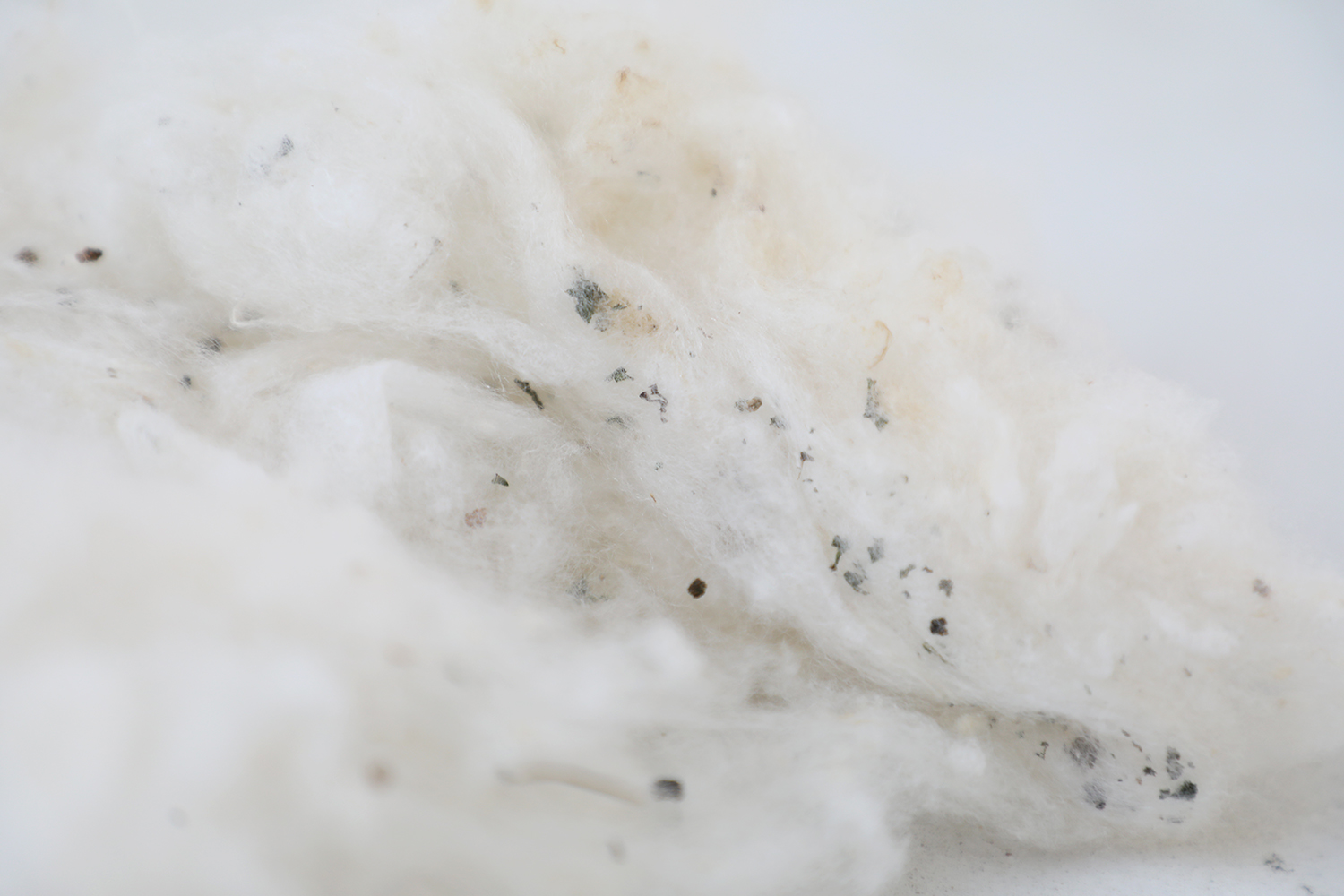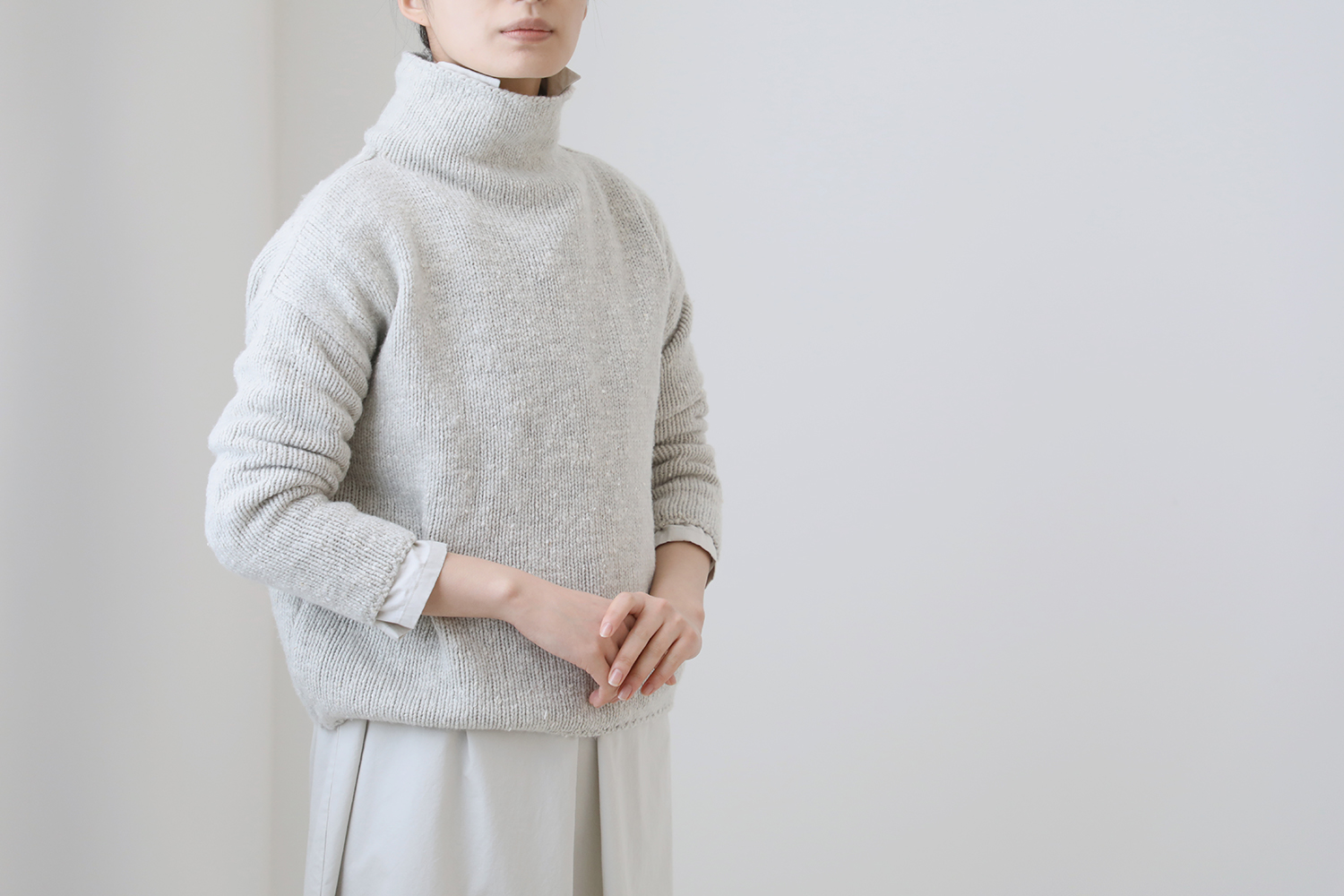ものや人との繋がり、そして時の流れが紡ぎ出す循環をテーマにした今季秋冬コレクション。連載三回目は、蚕から生みだされる繭の毛羽がニットになるまでをご紹介します。
先人たちの知恵や技術を受け継ぎながら、ものづくりに取り組む人たちの想いとともにお届けします。
蚕から毛羽へ
かつて日本の主要産業の一つであった養蚕業。何千年も人々の暮らしを支えてきた養蚕は、次第に安価で大量生産を重視した時代へと移りゆき、多くが途絶えてゆきました。昔は桑畑がたくさんあり、養蚕をされる農家が多く存在した山梨県も今では5件、全国でも200件ほどとなってしまいました。そんな中、山梨で150年以上にわたり今もなお、養蚕業を営む芦澤さんと出会い、蚕から繭になるまでの道のりを辿りました。
甲府盆地を見渡せる高台に位置する富士川町。150年以上続く養蚕農家のアシザワ養蚕六代目の芦澤洋平さんと2021年の夏に出会いました。代々続けてこられた家業ですが、業界を取り巻く環境の変化や、気候の移り変わりにより夏の高温時期に蚕の飼育が困難になっていることなど、つくり手としての状況や思いが交差し、共に何かを生み出すことができるのではという朧げな思いで現地を見学させていただくこととなりました。
アシザワ養蚕さんは、evam eva 本社から車で10分ほどの小高い山の中腹、開けた集落の風通しのよい場所に位置しています。庭の所々に大きく茂る桑の木に、その営みの跡を感じます。小屋に入ると、サワサワと静かに降り注ぐ小雨のような音が聞こえてきました。音の方へ近づいてみると、蚕が桑の葉を食べている音でした。春の季語に、蚕たちが桑の葉を食べるときの音を表現した「蚕時雨」という言葉が古くから存在するほど、養蚕が人々の暮らしに根付いていたことが伺えます。
「周りが養蚕をやめていく中で、養蚕を続けてきた祖父と父のおかげで六代目として続けられています。小さい頃は理解できなかった養蚕業も、今は心から好きでやっています。好きなことを仕事にできること、祖父と父にはとても感謝しています。」(芦澤さん)
そう話しながら、蚕の成長してゆく過程を丁寧に説明してくださいました。
6000年以上も昔から織物に使われてきたシルク。糸のもとになるのは、蚕が身体の周りを包み込みながらつくる繭。シルクには吸湿性と放湿性があり、強さ、しなやかさが備わっています。そのどれもが蚕自身が自らの命を守り、生きるために繭に与えたもの。
一日中桑の葉を食べ続け、大きく成長した蚕は、「まぶし」という段ボールでつくられた枠の中に入り、30日ほどで繭をつくります。さなぎになる時に、糸を吐き始めてから終えるまで途切れることなく一本の糸で繭をつくります。ひとつの繭から生まれる糸は1500mほど。自然界で唯一の長繊維です。養蚕には微妙な温度・湿度調節が求められます。蚕が過ごしやすい温度に管理すること、質のよい新鮮な桑を与えることで、健康な蚕が育ち、良質な繭をつくってくれます。より良質な糸をつくりだすために家蚕は長きに渡り品種改良が重ねられた、自然では見られない生きものです。ほとんど移動をせず、成虫になり羽が生えても飛ぶこともできません。人の手で育てなければ生きていくことができないのです。
「粒の揃った綺麗な繭をつくることが、養蚕農家に求められていることです。毎年気候条件が全く違っていて、年々蚕にとっては厳しい状況となってきていますね。適した気温、必要量の桑、蚕から求められてることは変わらないけれども、周りの環境が変わってきてるので、そこで臨機応変にどうできるかなっていうところですね。それにはまだまだ未熟なところもありますので、父から教わりながら、日々手探りで蚕と向き合っています。」(芦澤さん)
段ボールからできている「まぶし」という枠一つひとつにつくられた繭を毛羽取り機に通して、繭の周りを覆う毛羽を綺麗に取り除きます。繭毛羽は蚕が繭をつくる際に最初に吐きだす糸で、自らの足場づくりとなるため、糞や桑の葉、枝がたくさん付着しています。そのため除去された毛羽は生糸にはならず、ただ廃棄されてしまうそうです。はじめてアシザワ養蚕さんを見学した際に、繭毛羽のことを知りました。触れてみると柔らかく、シルク独特の艶もあり、捨てるのはもったいないと感じました。これも上質なシルクの価値として素材にできないか、という思いが始まりでした。糸の原料として繭毛羽を使用するには、まず毛羽に混ざり込んだ糞や桑の葉を取り除く作業をします。専用の機械があるわけではないので、試行錯誤しながら風力で取り除いていきます。
「養蚕業の中で繭が一番の主力だけれども、繭以外にも価値があることは前々から思っていました。生産者としては育てた繭は余すことなく使いたいという思いはあります。なかなかその魅力を伝えることができずに勿体ないと思い続けながら、捨てるしかなかった繭毛羽。今回こういう機会をいただきとても有難いと思っています。うちだけでは足りなかったので、他の養蚕農家さんにも声をかけて、ご協力いただき毛羽を集めましたので、農家さんのためにもなっていると思います。毛羽ってこういう使い方ができるんだっていうことが認知されるようになれば、今まで捨てていたようなものに価値があることを知ることで、大切に思う気持ちが生まれてくると思いますし、より良い循環になっていくように感じています。そして、それは一番蚕のためになるのかなと思います。養蚕農家が強くなれば、その先も沢山の蚕を飼うことでき、来年、10年後、100年後と続いていくことができる。」(芦澤さん)
野生では生きていけない蚕。生業の中で生きていくために生まれ、人と蚕との関係がずっと存続してきた歴史があって今がある。そこでは変わらずに、人と蚕が共に生かされながら繋がってゆくこと、また蚕からの恩恵を余すことなくいただくことへの思いを感じました。
そうして手にした繭毛羽を糸にするために紡績をしますが、新しい糸の開発にも多くの時間と技術を要します。そこで毎シーズン素材の開発や提案をしてくださっている、愛知県一宮にある東和毛織さんにお願いし、開発担当の工藤さんにご協力いただくこととなりました。一宮を中心とする尾州は毛織物の産地であり、紡績から整理加工まで、繊維業界を担う企業が多くあります。
毛羽から糸に
白くきれいに整えられた繭毛羽は、紡績工場で糸へと紡がれてゆきます。毛羽だけでは繊維が短く糸にすることができないため、繊維長の長い新たなウールと合わせて糸にしていきます。まずは、繭毛羽のわたとスライバー状のウールの繊維を混ぜ合わせます。繭毛羽は不均一なわたの状態であるため、機械上を流れるウールの中に手作業で混入させるという工程を考案してくださいました。混紡方法や混ぜ合わせる回数を細かく調整し、あえて均一にしすぎず混ぜることで、繭毛羽そのものの表情を残すようにしました。白いウールのスライバーは、一見白一色のようですが、よく見るとブラウンやブラックなどの色が混ざりあっています。複数の色を重ね合わせることで繭毛羽とも自然に馴染み、奥行きのある色合いに仕上がります。
新たなウールとブレンドしたわたを引き伸ばしながら、旧式紡績機でゆっくりと丁寧に紡いでいきます。 ネップなど繭毛羽の存在を感じられるように、工程はなるべくシンプルであることを大切にし、甘く撚りをかけて太番手の糸に撚り合わせます。
「最初に繭毛羽を見たとき、手紡ぎのような糸をイメージしました。繭毛羽の存在は残しつつ、手で紡ぐ柔らかな雰囲気を機械を使ってどう糸にしていくかを考察していきました。糸づくりは、想像することが大切です。今まで培った素材の知識を繋げて、求める風合いの糸に仕上げていく。できないと言ってしまうことは簡単ですが、自分一人の発想だけだと限界があるので、撚糸や染め、紡績それぞれの現場の人と享受し合うことで、新しいものが生まれると思っています。」(工藤さん)
撚りをかけ終えた糸を綛上げ機と呼ばれる機械を使って 、手作業で綛上げします。カタカタと手車を回す音が心地よく響き渡ります。糸の表面に付いた油分などを落としたり、 糸自体を馴染ませるために、糸を輪に束ねて洗います。洗いあがった糸を糸管に巻き上げて編み糸となります。
「生業がきちんと残っていることが貴重だなと感じます。実際、糸になるまでの工程には自分たちではできない作業がたくさんあります。そういった担い手には、お年を召した方が一生懸命誇りを持って働いてる姿があっても、そこに若い人の姿が見えないですね。いつも持続可能って素材のことは言われますが、つくり手が繋がらないことで素材自体の生産が持続不可能になってきてしまっています。そうならないように、毎シーズン同じ人へ仕事を渡し続けることで、つくり手同士が繋がり、感覚を共有し合いながら、良い循環が生み出せればと思っています。」(工藤さん)
形あるものへ
私たちのもとへ、糸となって還ってきた繭毛羽。その糸の表情、肌で触れた感触からインスピレーションを繋げて、形に仕上げていきました。繭のように身体をふわっと包み込むよう、ざっくりとやさしく編み上げました。繭毛羽の温かく柔らかな雰囲気を淡い色で表現しています。
よいものがこれから先も続いていくことは、今ある暮らしを豊かにすることと同じくらい大切なことだと感じています。先ずはそのことに目を向けて考え、想像し、手を動かしながら形にしていくことで、それぞれの生業が繋がり、そこにまた新しい循環が生まれる。受け継がれた歴史と新しい変化を楽しみながら、自分たちの手で蘇らせ、生み出す喜びを共に感じ得ることのできた試みでした。
ご協力いただいた芦澤さん、全国の養蚕農家さん、東和毛織さん、今回の取り組みに携わっていただいた沢山の方々に感謝いたします。
silk wool turtleneck|E223K093 phantom gray ¥27,500
*モデル着用アイテム
column|link the loop vol.3 linking livelihoods
The theme of this season’s fall/winter collection is link the loop/circulation by the flow of time and the connections between things and people.In the third part of the series, we introduce how the fluff from cocoons produced by silkworms is turned into knitwear.
We present you with the thoughts of the people involved in the craftsmanship, inheriting the wisdom and techniques of their predecessors.
from silkworm to fluff
Yamanashi Prefecture, where there used to be many mulberry fields and many silkworm-farming farmers, now has only five such farms and about 200 in the whole country.In this situation, we met Mr Ashizawa, who still runs the sericulture business in Yamanashi for more than 150 years, and traced the path from silkworms to cocoons.
Located on a hill overlooking the Kofu Basin, Fujikawa-cho is an open and airy village on a small mountainside about 10 minutes by car from the evam eva head office.The large mulberry trees growing in places in the garden show traces of their work.In the summer of 2021, we met Yohei Ashizawa, the sixth generation of Ashizawa Sericulture, a sericulture farm that has been in existence for more than 150 years. The family business has been carried on for generations, but the changes in the environment surrounding the industry and the changing climate have made it difficult to raise silkworms during the high summer temperatures. We decided to visit the site with the vague hope that our circumstances and thoughts as makers would intersect and we would be able to create something together.
‘Thanks to my grandfather and father, who continued sericulture while everyone around them was quitting, I am able to continue as the sixth generation. I didn’t understand sericulture when I was a child, but now I love it with all my heart. I am very grateful to my grandfather and father for allowing me to do what I love.”(Mr Ashizawa)
While talking about this, he carefully explained the process of growing silkworms.
Silk has been used in textiles for over 6,000 years.The source of the thread is the cocoons that silkworms make by wrapping themselves around their bodies. The silkworms feed on mulberry leaves all day long and grow large, then enter a frame made of corrugated cardboard called a ‘mabushi’, where they make cocoons in about 30 days.When the silkworm becomes a pupa, it makes a cocoon with a single uninterrupted thread from the moment it begins to spit out its thread until it finishes. Raising silkworms requires delicate temperature and humidity control.By controlling the temperature at which the silkworms are comfortable, and by feeding them fresh mulberry of good quality, healthy silkworms will grow up and make high-quality cocoons.The silkworm is a creature that cannot be found in nature and has been bred over a long period of time to produce better quality yarn. They rarely migrate and cannot fly even after they have grown into adults and grown wings. They cannot survive without human care.
‘Producing beautiful cocoons with uniform grain is what is required of agriculturalists. The climate conditions are completely different every year, and it is becoming more and more difficult for the silkworms every year. The temperature is suitable, the amount of mulberry required and what the silkworms want are the same, but the environment around us is changing, so it’s a question of what we can do flexibly. I am still inexperienced in some areas, so I am learning from my father and dealing with the silkworms on a daily basis.” (Mr Ashizawa)
The cocoons made in each “mabushi” frame are passed through a fluff remover to cleanly remove the fluff that covers the cocoon’s surroundings. Cocoon fluff is the first thread expelled by the silkworms when they make cocoons, and as they provide a foothold for themselves, they are covered with droppings, mulberry leaves and branches. Therefore, the removed fluff is not turned into raw silk, but is simply discarded. I learnt about cocoon fluff when I visited Ashizawa Sericulture for the first time.When I touched them, they were soft and had a unique silk sheen, and I felt that it would be a waste to throw them away. To use cocoon fluff as a raw material for yarn, the first step is to remove the droppings and mulberry leaves mixed in with the fluff. As there are no specialised machines, they are removed by wind power through trial and error.
‘Cocoons are the mainstay of the sericulture industry, but I have long thought that there is value in more than just cocoons. As a producer, I want to use all the cocoons I grow.It has been difficult to convey the appeal of these cocoon fluff, and we have had no choice but to throw them away, while continuing to think that they are a waste. We are very grateful for this opportunity.We couldn’t do it alone, so we asked other sericulture farmers to help us collect the cocoon fluff, so I think it’s good for them too.If people become aware that they can use the fluff in this way, they will realise that something they used to throw away has value, which will make them feel that it is important, and I feel that this will lead to a better cycle.And I think that would be the best thing for the silkworms. If the sericulture farmers become stronger, then they can keep many more silkworms, and they can continue next year, ten years later, even a hundred years later.” (Mr Ashizawa)
The cocoon fluff is then spun into yarn, but the development of new yarn also requires a lot of time and technology. We therefore asked Towa keori in Ichinomiya, Aichi Prefecture, which develops and proposes materials every season, to cooperate with Mr Kudo, who is in charge of development. Bishu, centred on Ichinomiya, is a woollen textile production area, with many companies involved in the textile industry, from spinning to finishing.
from fluff to yarn
As the fibres are too short to be made into yarn from the clean white cocoon fluff alone, they are combined with new wool with longer fibres to make yarn.First, the cocoon fluff wadding is mixed with sliver-like wool fibres.As the cocoon fluff is in an uneven wadding state, they has devised a process whereby it is mixed manually into the wool flowing on the machine.The white wool sliver appears to be all white, but closer inspection reveals a mixture of colours such as brown and black.By layering multiple colours, it blends naturally with the cocoon fluff to create a colour with depth.
The yarn is slowly and carefully spun on an old spinning machine, stretching the blended yarn with new wool. The process is kept as simple as possible so that the presence of neps and other cocoon fluff can be felt, and the yarn is loosely twisted and twisted into a thick yarn.
‘When I first saw the cocoon fluff, I imagined a yarn that looked like handspun.While retaining the presence of the cocoon fluff, we considered how to transform the softness of hand spun into yarn using a machine.Imagination is the key to yarn making.We connect the knowledge of materials we have developed and create the yarn with the texture we are looking for.It’s easy to say it cannot be done, but there are limits to what you can achieve if you only have your own ideas, so I believe that new things are born by sharing them with people in the twisting, dyeing and spinning fields.” (Mr Kudo)
After twisting is completed, the yarn is manually reeled up using a machine called a reel lifter.The sound of the hand-wheel being turned resonates pleasantly.In order to remove oil and other substances from the surface of the yarn, and to acclimatise the yarn itself, the yarn is bundled into a loop and washed.The washed yarn is then wound up in a tube to become knitting yarn.
‘I feel it is valuable that the livelihood remains in good order.In fact, there is a lot of work that we cannot do ourselves in the process of turning into yarn.There are elderly people working hard and proudly at these bearers, but I don’t see many young people there.People always talk about sustainable materials, but the production of the materials themselves is becoming unsustainable because of the lack of young makers.To prevent this from happening, I hope that by continuing to hand over work to the same people every season, the makers can connect with each other, share their senses and create a good circulation.” (Mr Kudo)
to the things with shape
Cocoon fluff returned to us as yarn.We were inspired by the expression of the yarn and the feel of them on our skin.We knitted it gently and roughly so that it would softly wrap around the body like a cocoon.The warm and soft atmosphere of the cocoon fluff is expressed in light colours.
We feel that it is just as important to ensure that good things continue to be made in the future as it is to enrich the way of life we have now.By first looking at this, thinking about it, imagining it and giving shape to it with our hands, our respective livelihoods will be connected and a new circulation will be born there again.It was an experiment where we were able to enjoy the inherited history and new changes, and feel the joy of reviving and creating with our own hands.



